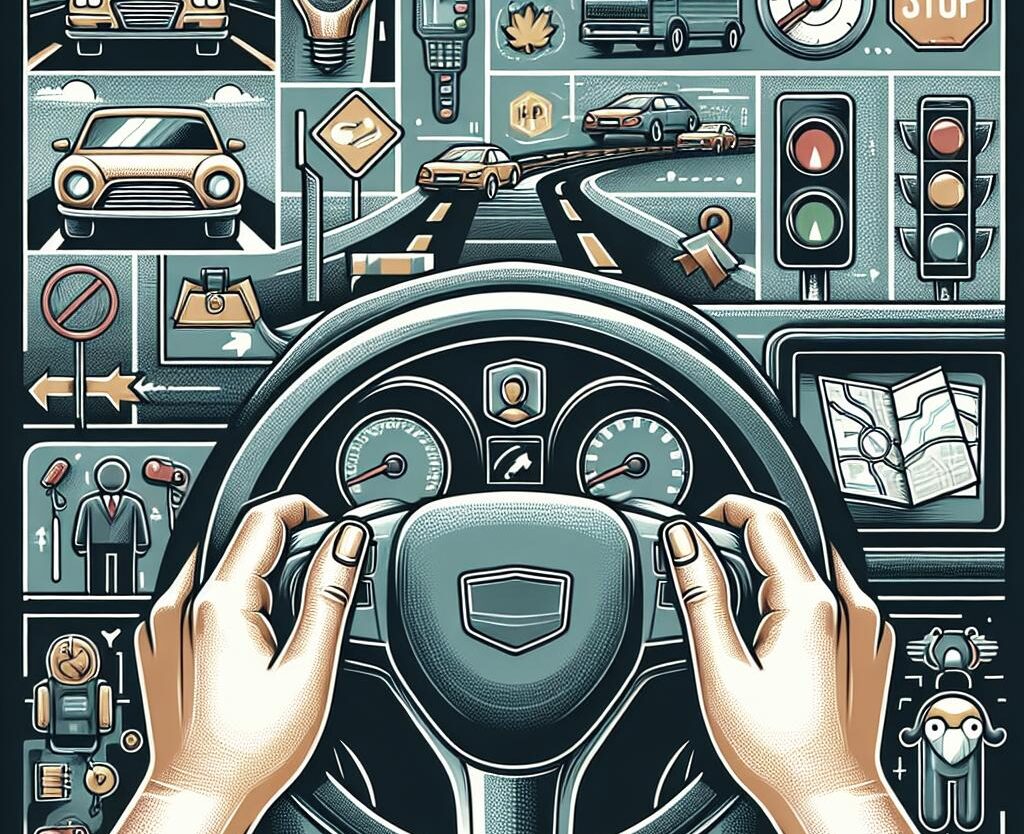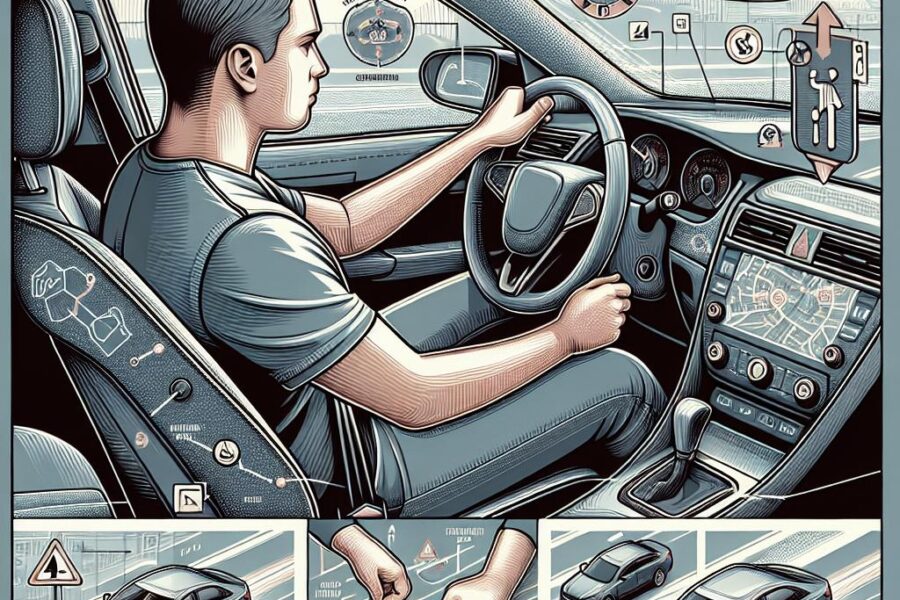How to Drive: A Comprehensive Guide for Beginners
Jumping into the driver’s seat for the first time can be both thrilling and overwhelming. Whether you’re learning to drive a manual or an automatic car, understanding the basics is crucial. In this complete guide, we will walk you through the essential steps for operating both types of vehicles. From preparations for your first lesson to navigating in traffic safely, you’ll gain the confidence needed to handle various driving situations. We’ll also share practical tips for parking and reversing, ensuring you’re ready to hit the road with assurance and safety.
Preparations for Your First Car Driving Lesson
Before diving into the world of driving, it is important to make a few preparations. Start by familiarizing yourself with the vehicle; know where the controls, mirrors, and pedals are located. Make sure your seat is adjusted to a position where you can comfortably reach all the controls, ensuring optimal visibility.
Another crucial step is obtaining a learner’s permit if your region requires one. This document declares that you are legally allowed to learn driving under certain conditions. Some areas might have specific age criteria or need you to pass a written test that covers basic driving rules and regulations.
Lastly, set the right mindset by staying relaxed and open to learning. You’ll make mistakes, and that’s perfectly okay. Choose an experienced instructor—either a professional or someone you trust—to guide you through your early experiences. Feeling comfortable with your guide will make the learning process much smoother and enjoyable.
Beginner’s Manual Car Driving Guide
Step 1: Start the Car in Neutral
Begin by ensuring the car is in a secure neutral position. Insert the key into the ignition or use the start button in modern cars to start the engine. Press the clutch pedal completely to the floor before turning the ignition. This prevents any jerking or lurching, which can happen if the car is accidentally left in gear.
While keeping the clutch depressed, use your other foot to press lightly on the brake pedal. Double-check that the handbrake is engaged to prevent any unexpected movement. Releasing the clutch too soon can cause the engine to stall, so it’s crucial to maintain control.
Listen to the engine as it springs to life, making sure everything sounds normal without any unusual noises. Once you feel confident that the car is stable, you’re ready to start your journey by shifting into first gear—a significant initial step in manual driving.
Step 2: Engage the First Gear
To engage the first gear, keep the clutch pressed and move the gear stick from the neutral position to the first gear slot. First gear provides the most torque, helping the car to start moving from a standstill. Carefully, begin to lift your foot off the clutch pedal while gently pressing down on the accelerator with your right foot.
The art of finding the clutch’s biting point is essential. This is the balance point where the clutch starts to engage, and you’ll feel the car wanting to move. It requires practice to master the timing and coordination, but with experience, it will become second nature.
Be patient and avoid rushing this step. If the engine stalls, remain calm—just reset by pressing the clutch, putting the car back in neutral, and restarting the procedure. The goal here is to smoothly engage the gear without any juddering or stalling.
Step 3: Get the Car Moving
With the first gear engaged, it’s time to set the car in motion. Slowly release the handbrake while continuing to adjust the clutch and accelerator balance. This will start your car’s forward momentum, so be mindful of other vehicles or obstacles around you.
Gain a feel for the vehicle’s response to your inputs—how softly or heavily you need to press the accelerator, and how quickly you should release the clutch. Every car is different, and getting accustomed to its unique responsiveness will take some time.
Keep your hands firmly but gently on the steering wheel. Steer smoothly and be aware of your surroundings to make necessary adjustments. Practicing in an open space free from traffic can provide a safe environment to perfect starting and maneuvering techniques.
Step 4: Shift to Higher Gears
As you accelerate, the next step is transitioning into higher gears. The first gear is only for low speeds, primarily getting the car moving. Listen to the engine—the louder and higher-pitched the sound gets, the closer you are to changing gears.
To shift up, relieve pressure from the accelerator, depress the clutch completely, and move the gear stick to the next gear slot—typically second gear. The transitions should be smooth to avoid jerky movements. Once the new gear is engaged, gently reapply pressure to the accelerator while releasing the clutch.
Synchronizing the clutch with the gear change is an acquired skill that’s crucial for both car performance and safety. Aim for seamless transitions to maintain steady acceleration without over-revving or stalling.
Step 5: Downshift to Lower Gears
Downshifting is just as important as shifting up. When slowing down or requiring more power for tasks like climbing a hill, you’ll need to engage lower gears. Ease off the accelerator, press the clutch, and move the gear stick to the lower gear needed.
When downshifting, be mindful of engine speed and road conditions. Lower gears produce higher engine revolutions, so transitioning smoothly is key. This process enhances control, especially in tricky driving situations or when preparing to stop.
Rev matching can be helpful for advanced learners, reducing wear on the clutch and providing a smoother downshift. As you practice, you’ll get a feel for the most appropriate times and techniques for downshifting, improving your driving finesse.
Step 6: Bring a Manual Car to a Stop
Stopping a manual car safely involves a combination of clutch and brake use. Slow down by easing off the accelerator and pressing the brake gently. Press the clutch fully as you near a complete stop to prevent stalling.
The brake light signals your stopping intentions to drivers behind, so start braking early enough. As you slow down, downshift to the appropriate gear if you’re still in motion. This enhances braking efficiency and engine control.
Once the car is stationary, shift the gear stick back to neutral and engage the handbrake. Release the clutch, and you’re now safely stopped. Practice makes perfect, so continue rehearsing these stops to build confidence and control.
Step 7: Reverse with a Manual Car
Reversing in a manual car requires attention to controls and surroundings. Ensure the vehicle is at a complete stop, and then press the clutch and shift the gear stick into reverse. Look around and check mirrors for a clear path before proceeding.
Releasing the clutch slowly while gently applying the accelerator ensures a controlled reverse movement. Unlike forward driving, visibility is limited, so rely heavily on your mirrors and shoulder checks to navigate confidently.
Reverse slowly and deliberately, making steering adjustments as needed. Practice in open spaces can help build the necessary skills to handle more constrained or complex reversing scenarios in real-world situations.
Step 8: Park a Manual Transmission Car
When parking a manual, your objective is stability. As you bring the car to a halt, use the clutch and brake effectively to avoid stalling. Once stopped, place the gear stick in first gear or reverse, acting as an extra safeguard against rolling.
Engage the handbrake firmly to secure your parked car. On inclines, turning the steering wheel towards the curb offers an added layer of safety, ensuring wheels rest against the curb if the car moves.
Parking takes practice, especially in boundary-limited spaces. Use mirrors for precise positioning, and don’t hesitate to correct and adjust your parking process to ensure the car is well-aligned within the parking space.
How to Learn Driving an Automatic Car
Step 1: Start the Car
Starting an automatic car is straightforward. Ensure it’s in ‘Park’ (P) and hold the brake pedal before turning the key or pressing the start button. Automatic vehicles won’t start if the gear isn’t set to ‘Park’.
Listen for the hum of the engine as it starts, ensuring the car is ready to go. Familiarize yourself with basic controls such as indicators, windshield wipers, and the air conditioning before you begin driving.
If the car doesn’t start, check if all doors are closed and reattempt. For keyless ignition systems, ensure the key fob is inside the vehicle. With the car on, you’re set to begin learning the dynamics of automatic driving.
Step 2: Choose a Gear
Once the car is on, select the appropriate gear for your driving needs. The gear lever will typically have options such as ‘Drive’ (D) for moving forward, ‘Reverse’ (R) for backing up, and ‘Neutral’ (N) as well.
To move forward, press the brake pedal and shift the gear lever from ‘Park’ to ‘Drive’. You can then release the brake gently to start forward motion. Once you’re in motion, the automatic transmission will handle the gear shifts seamlessly.
Remember that automatic cars do not require a clutch pedal, simplifying the driving process. Just focus on using the two pedals: the brake and the accelerator, making it an ideal choice for beginner drivers.
Step 3: Disengage the Parking Brake
Before moving, double-check the parking brake. Ensure it is fully released. Some modern vehicles come equipped with electronic parking brakes; disengage them by pulling a lever or pressing a button, depending on your car model.
Failing to release the parking brake can lead to reduced efficiency and even damage. It’s good practice to verify this essential step is completed every time you plan to drive.
With the brake disengaged, maintain a foot on the brake pedal to prevent rolling, especially on gradients. This control step is vital in ensuring a smooth transition from stationary to moving positions.
Step 4: Move the Car
With the gear set to ‘Drive’ and the parking brake disengaged, you’re ready to move. Gently release the brake pedal and apply light pressure on the accelerator to start rolling ahead.
The car will start gliding forward as you apply more pressure to the accelerator. Keep your movements smooth and deliberate to maintain control and comfort.
In automatic vehicles, the transition through gears is handled by the car itself. This provides a placid driving experience, allowing you to concentrate more on steering, traffic flow, and road rules without the extra task of manual gear changing.
Step 5: Utilize Neutral Gear
The ‘Neutral’ gear is handy in situations where you don’t require engine power, such as during brief stops. Shift to ‘Neutral’ to minimize the strain on your vehicle while stopped at traffic lights or in heavy traffic.
In automatic cars, ‘Neutral’ is primarily for short stationary periods. It won’t engage the engine’s drive wheels, which settles the vehicle into a state of pause rather than movement.
Remember: Avoid using ‘Neutral’ while the vehicle is in motion, as it takes away your ability to control engine speed, potentially reducing your control over the car. Instead, use it as a convenient pausing tool for short halts.
Step 6: Employ Lower Gears
Automatic cars often have a lower gear setting indicated as ‘L’ or ‘1’. These gears come into play when driving downhill or at times when you need heightened engine braking power.
In adverse conditions like steep slopes or towing weights, switching to a lower gear helps maintain control and prevent the vehicle from accelerating excessively due to gravity.
Practice using these gears to get a feel for when and how to employ them effectively. While automatic vehicles usually manage gears independently, being familiar with lower gear use can significantly enhance your driving expertise.
Step 7: Halt the Car
Stopping an automatic car is simple. Gradually lift off the accelerator and gently apply the brakes to reduce your speed, slowing the vehicle to a stop.
As you stop, shift the gear back to ‘Park’ to engage the locking mechanism; this prevents the car from rolling when stationary.
Ensure the parking brake is actuated before you exit the vehicle. This acts as an additional safety measure, especially when parked on slopes or uneven terrain.
Step 8: Reverse in Automatic Mode
Reversing in an automatic car is user-friendly. Start by coming to a complete stop, then press the brake and shift the gear lever to ‘Reverse’. Keep an eye on your surroundings through mirrors and over your shoulder.
Slowly release the brake to begin backward movement. Apply throttle control lightly to modulate your reversing speed, maintaining awareness of all directions.
Reverse parking is an essential skill. Practice should incorporate different scenarios like close spaces or parking bays to build your confidence. Always confirm the area is clear before and during the process.
Step 9: Park the Car
Parking an automatic vehicle involves similar steps as halting. Once stopped, ensure the car is in ‘Park’ to lock the transmission safely. This prevents unwarranted vehicle movement.
Engage the parking brake for additional stability, assuring the car stays secure, especially if parked on an incline. This dual security strategy minimizes the risk of your car moving involuntarily.
Whether parking on a street or in a garage, diligent use of mirrors and environmental awareness are paramount. Align your vehicle accurately with the designated space, executing careful final adjustments for a perfect park.
Tips for Driving in Traffic
Handling traffic requires composure and strategic planning. Maintain a safe following distance, giving you ample time to react to unexpected stops or movements of other drivers.
Use your mirrors regularly, keeping an eye on both sides and behind you. This spatial awareness minimizes blind spots and enhances your readiness to react to changing traffic conditions.
Stay calm, especially during rush hours. Anticipate stops, avoid frequent lane changes, and use indicators well ahead of your planned turns. Smooth and calculated drive movement is key to navigating traffic fluidly.
Essential Safety Tips for Driving
Safety on the road begins with adherence to speed limits and regulations. They are there for a reason: prioritizing the safety of everyone on the road.
Practice defensive driving by being vigilant, anticipating potential risks, and preparing to address them without overreacting. Awareness and foresight keep you prepared for sudden changes from other road users.
Always buckle up, stay sober, and avoid distractions like mobile devices. Concentration and common sense make up your best safety toolkit while driving. Being responsible not only protects you but also enhances safety for all road users.
FAQ
How can I drive for the first time?
To drive for the first time, obtain a learner’s permit by passing the requirements set by your local DMV or licensing authority. Start with a licensed adult accompanying you, practice in a quiet area, and familiarize yourself with the car’s basic controls. Focus on learning road rules, staying calm, and gradually gaining experience in different driving conditions.
What are the basics of driving?
The basics of driving involve understanding and operating the vehicle’s controls including steering, brakes, and accelerator. You must obey traffic laws, signals, and signs while maintaining awareness of your surroundings. Practice defensive driving by anticipating other drivers’ actions and adjusting your behavior accordingly.
Is it easy to learn to drive?
Learning to drive varies in difficulty depending on the individual. Some people find it straightforward, while others may take longer due to nervousness or coordination skills. Overall, with practice and proper instruction, most people can learn to drive.
What is the easiest way to learn to drive?
The easiest way to learn to drive is to take lessons with a certified driving instructor who can provide structured guidance and feedback. Practice regularly in a safe and controlled environment to build confidence and skills. Familiarize yourself with traffic laws and safe driving techniques through a driver’s manual or online resources.
Final Thoughts
| Section | Overview |
|---|---|
| Preparations for Your First Car Driving Lesson | Familiarize with the vehicle, obtain learner’s permit, and adopt a positive mindset. |
| Beginner’s Manual Car Driving Guide | Step-by-step instructions for driving a manual car, from starting the engine to parking. |
| How to Learn Driving an Automatic Car | Procedure for handling an automatic vehicle, from gear selection to safe halting. |
| Tips for Driving in Traffic | Strategic advice for maintaining safety and composure during congested driving conditions. |
| Essential Safety Tips for Driving | Key safety habits including adherence to speed limits and practicing defensive driving. |





